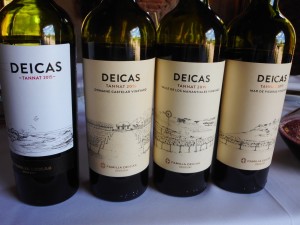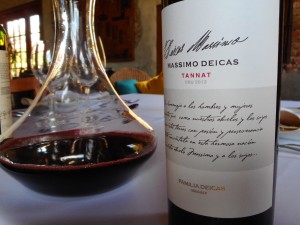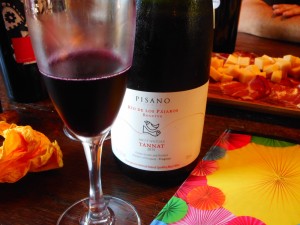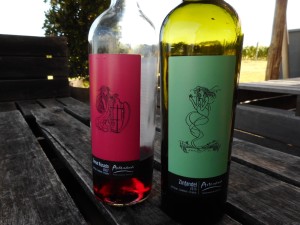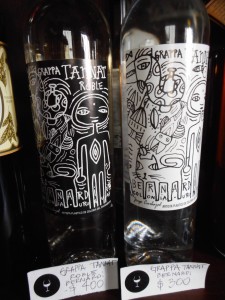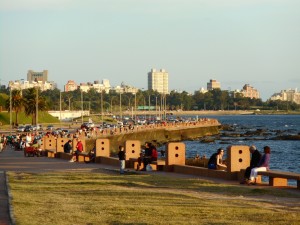Today we have a post from guest blogger Lucia Volk, CWE. Lucia tells us about a recent trip to Uruguay, where she toured the wineries and tasted the local wine, which in this case happened to include some world-class Tannat!
When I watch sports games, I tend to root for the underdog. Drinking wine, I feel drawn to bottles that are lesser known. While I congratulate estates and regions that enjoy high sales volumes because everyone agrees they are great, I truly admire winemakers who toil knowing that their wines will not easily find a space on a wine list or store shelf, no matter how good and how genuine the bottles they produce.
Uruguay remains an underdog in the South American wine world, despite the quantum leap forward in quality wine production in the Canelones and Maldonado regions over the past decades. You probably remember the last time you had an Argentinian Malbec or Chilean Cabernet, but when did you pour your last glass of Uruguayan Tannat?
I recently had the opportunity to travel to Uruguay, and I can tell you right off the bat that everything that the travel literature says about how friendly and welcoming the Uruguayans are is true. Moreover, winemakers I met were philosophical, (com)passionate, perfectionist, with a hint of non-conformist and quirky thrown into the mix—not every day do you encounter a wild hog kept as a vineyard pet, as you do at Los Nadies in Santa Lucia, Uruguay.
Canelones, the main wine region outside the capital, features a mildly hilly terrain crisscrossed by rivers, and inhabited by colorful birds. Agriculture makes up a significant part of the country’s GDP. If you have recently eaten top quality grass-fed steak, it may have been raised in Uruguay.
Winemakers search for poorer soils in the windier, coastal areas to plant their vines. Blessed with abundant sunshine and nightly cooling breezes from the ocean, their grapes ripen slowly and maintain a refreshing acidity. In most years, rain is sufficient and occurs at the right time, allowing for dry farming. Recurring humidity requires the application of copper/sulfur sprays during the growing season, but pesticides or fertilizers are generally not needed. Contrary to Argentina and Chile, most wineries in Uruguay are small to moderately-sized and family-owned. Chile’s Concha y Toro produces more than all of Uruguay put together on the 11,000ha it owns.
So if you want a hand-crafted South American red, sustainably farmed, your best bet is a bottle from Uruguay. Their specialty is the robust, red Tannat grape, imported by Basque migrants at the end of the 20th century. While the European version of Tannat tends to live up to its tannic name, requiring extended aging before it shows its full potential, Uruguay’s more moderate climate and modern cellar practices—cold soaking and cool maceration—yield a softer version of Tannat, one that can be enjoyed quite young.
In a still, dry, single-varietal Tannat you can expect to find tannins and acidity, for sure, alongside plum and blackberry, plus secondary aromas of French and American oak. It is the perfect complement to grass-fed Uruguayan beef, fresh off the grill. Single varietal Tannat is varied, as I learned at a comparison tasting at Deicas Winery in Juanico. While every bottle—Mar de Piedras, Valle de los Manatiales, and Domaine Castelar—had a peppery-spicy-smoky component, there were clear differences between grippier, earthier wines and more velvety, vanilla-and-plum versions. The 2013 flagship Massimo Deicas Tannat was densely layered with aromas and flavors, a wine that will make you a believer.
Tannat’s grippiness can be tamed. Frequently, you find it blended with Merlot (Equilibrio, Los Nadies; Gran Guarda, Stagnari) and the less tannic [!!] Cabernet Sauvignon (Rio Colorado, de Lucca). Less frequently, it is blended with Syrah (de Lucca), Zinfandel (Artesana, the only Uruguayan Zin producer so far) or Viognier (Alto de la Ballena). You can reduce the tannin load by fermenting Tannat entirely in stainless steel (Bouza, sin barrica). You can submit Tannat grapes to carbonic maceration and produce a berry basket of aromas easy on the palate (Don Prospero, Pizzorno). You can turn Tannat into a refreshing, bright red, raspberry rosé (Tannat Rosado, Artesana). You can even produce an acid-driven base wine, add more sugar, and re-ferment, hand-riddling it into a deeply colored, dry sparkling wine (Brut Nature, Gabriel Pisano).
You can also dry the grapes—think Recioto and Amarone—and fortify Tannat to produce a purple-colored, spicy chocolate, peppery blackberry sweet desert wine (EtXe Oneko, Gustavo & Gabriel Pisano). And of course you can distill Tannat into a version of grappa (Bernardi). The options are endless! It was fun to witness the inter-generational discussions between Gabriel and his uncle Daniel Pisano, or Agostina and her father Reinaldo de Lucca about new ways to produce or market Uruguayan wines. Family wine-making means preserving traditions, yet also moving along with the times.
Tannat is not only tasty, it is also good for you! Polyphenols, compounds found in the skins and seeds of grapes, are responsible for most of the wine’s aromas. Among polyphenols are procyanidins, which have been shown to inhibit cholesterol plaque in blood vessels. Tannat contains almost four times as many polyphenols as Merlot or Cabernet Sauvignon. Turns out that the tannin that gives the grape its name takes care of your heart!
Of course grapes other than Tannat grow in Uruguay, especially Bordeaux and Northern Rhone varietals. While most of Uruguay’s wine is red, whites are also produced. I was able to try remarkable Riesling, Albariño, Viognier, Torrontés, Sauvignon Blanc and Chardonnay. A recently established winery that is generating significant international buzz is Garzón in the eastern Maldonado region. Conceived and financed by Argentine billionaire Alejandro Bulgheroni in consultation with Alberto Antonini, Garzón covers nearly 10,000 acres and uses the most up-to-date vinification technologies. Garzón’s Tannat Reserva 2015 made the Wine Spectator’s Top 100 Wines of 2017, the first Uruguayan wine to be thus honored.
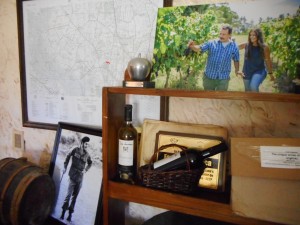
Reinaldo and Agostina De Lucca’s photograph on shelf in tasting room, next to a vineyard map and Che…
If you are eager to explore Uruguay, I recommend reading the Uruguay chapter in Evan Goldstein’s Wines of South America, and studying www.uruguaywinetours.com, which lists all the wineries that are open to visitors. The website makes it easy to contact bodegas ahead of time and arrange a tour. One thing to keep in mind is that Uruguay enforces a “zero tolerance law” that forbids drinking-and-driving. The solution is to hire a car for the day, or take a cab or ride share to where you want to go. Most Canelones wineries are 20-40 min outside the capital. If you want to visit Maldonado wineries, plan to spend a night in the lovely beach town of Punta del Este.
Beyond wine, Uruguay offers natural beauty. It has an amazing coastline and expansive interior. Montevideo features museums, galleries, and restaurants. Its rambla, nearly 14 miles of uninterrupted sidewalk along the Rio de la Plata, bustles with locals, who drink their mate tea or other beverage of choice, waiting for the sunset. You can pick up a friendly game of basketball or soccer in parks along the rambla or chat with cheerful locals walking their dogs. And do not forget to stop by the Montevideo Wine Experience, the friendliest wine bar on earth, on your way out of town, to sample local wineries you did not have time to visit.
If Uruguay is a bit too far for you right now, ask your local store to stock Tannat or your favorite restaurant to include one on its wine list, if they don’t do it already. Uruguayan wines have grit and personality, and are made by people who love what they do. They stand proudly apart from the wines of their better known neighbors—underdogs, for the time being, among South American wines.
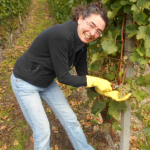 Photos and story by Lucia Volk, CWE. Lucia runs MindfulVine, a Wine Education business in the Bay Area that specializes in tailored, at-home tastings to promote a greater enjoyment of wine. She grew up in Germany, where her grandfather started a Riesling winery. She knows what it takes to work those steep slate slopes by hand, and decided to start promoting Riesling and other European wines after obtaining a PhD in Anthropology in the United States, and working briefly in wine sales.
Photos and story by Lucia Volk, CWE. Lucia runs MindfulVine, a Wine Education business in the Bay Area that specializes in tailored, at-home tastings to promote a greater enjoyment of wine. She grew up in Germany, where her grandfather started a Riesling winery. She knows what it takes to work those steep slate slopes by hand, and decided to start promoting Riesling and other European wines after obtaining a PhD in Anthropology in the United States, and working briefly in wine sales.
She now gets to have the best of two worlds and teach about global politics and cultures, as well as the many wonderful wine regions across the world. She is also working–slowly–on a book about the lesser known German Anbaugebiete.
Read more at:
- http://www.winetouristmagazine.com/wt-blog/2015/7/2/the-best-kept-secret-in-south-america-uruguay
- http://www.uruguaywinetours.com/language/en/
- https://www.facebook.com/pg/Montevideo-Wine-Experience-182066422126602/about/?ref=page_internal
- Click here for an excellent article, including a wine map of Uruguay on the Decanter.com website: http://www.decanter.com/wine-travel/south-america/uruguayan-coast-travel-guide-9255/
If you read Spanish, try also these links:
Are you interested in being a guest blogger or a guest SWEbinar presenter for SWE? Click here for more information!
